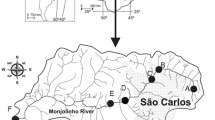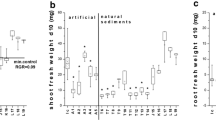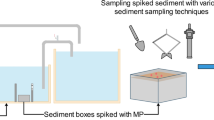Abstract
A series of acute toxicity studies exposed G. bonnieroides to different sediment particles (SP), materials used in whole sediment toxicity identification evaluations (TIE), and environmental samples (ES). The results from different experimental steps have confirmed that no significant difference was found between treatments (SP and TIE) and their control samples, thus indicating that the species can be successfully used in this type of experiment. Due to the high survival percentage (97.5% average) observed in all test replicates, the species characteristics that enable it to be used as a standardized species, with high ecological representativeness in tropical ecosystem toxicity tests were discussed. Finally, environmental sample analyses were performed to validate the procedures and confirm the tested amphipod viability and suitability.
Similar content being viewed by others
References
ABNT NBR15638 (2016) Aquatic ecotoxicology - acute toxicity - test method in sediment with marine and estuarine amphipods. Brazil
Adams M, Stauber LJ (2008) Marine whole sediment toxicity tests for use in temperate and tropical australian environments: current status. Australas J Ecotoxicol 14:155–167
Amiard-Triquet C, Berthe T, Créach A, Denis F, Dourou D, Gevaert F, Mounerac C, Ramond J, Petit F (2009) Tolerance in organisms chronically exposed to estuarine pollution. In: Amiard-Triquet C, Rainbow PS (eds) Environmental assessment of estuarine ecosystems, a case study, vol 7. CRC Press / Taylor & Francis Group, pp 135–157
Anderson B, Phillips BM, Hunt JW (2001) Sediment toxicity identification evaluations san francisco bay regional monitoring program, for trace substances. San Francisco Estuary Institute (SFEI), Progress Report. San Francisco
ASTM E1367 – 03 (2014) Standard test method for measuring the toxicity of sediment-associated contaminants with estuarine and marine invertebrates. https://doi.org/10.1520/E1367-03R14
Bailey HC, Curran CA, Arth P, Lo BP, Gossett R (2016) Application of sediment toxicity evaluation techniques to a site with multiple contaminants. Environ Toxicol Chem 35:2456–2465
Barceló D, Petrovic M (2007) Sediment quality and impact assessment of pollutants. Barcelona
Batley E, Sthal G, Babut P et al (2005) Scientific underpinnings of sediment quality guidelines. In: Wenning J, Batley E, Ingersoll G, Moore W (eds) Use of sediment quality gulidelines and related tools for the assessment of contaminated sediments. SETAC Press, Pensacola, pp 39–119
Bay SM, Brown JS, Greenstein DJ, Jirik AW (2001) Toxicity of methyl-tert-butyl ether (MTBE) to California marine life. Southern California coastal water research project (SCCWRP) 1999 Annual report, California, United States
Bertoletti E (2011) A Escolha do Anfípodo Bentônico para Ensaios Ecotoxicológicos com Sedimentos Marinhos. J Brazilian Soc Ecotoxicol 6:1–7. https://doi.org/10.5132/jbse.2011.01.001
Bocherter R, Zettler ML (2010) Grandidierella (AMPHIPODA, AORIDAE) from Angola with description of a new sepecies. Crustaceana 83:1209–1219
Bortone G (2007) Sediment treatment — a general introduction. In: Bortone G (ed) Sustainable management of sediment resources sediment and dredged material treatment. 1 st Elsevier, Netherlands, pp 1–10
Brack W (2011) Effect-directed analysis of complex environmental contamination. Springer, Berlin, Heidelberg
Burgess RM, Charles JB, Kuhn A et al (1997) Development of a cation-exchange methodology for marine toxicity identification evaluation applications. Environ Toxicol Chem 16:1203–1211. https://doi.org/10.1002/etc.562016061
Burgess RM, Hawthorne SB, Perron MM, Cantwell MG, Grabanski CB, Miller DJ, Ho KT, Pelletier MA (2011) Assessment of supercritical fluid extraction use in whole sediment toxicity identification evaluations. Environ Toxicol Chem 30:819–827. https://doi.org/10.1002/etc.457
Burton GA (1992) Sediment toxicity assessment. Boca Raton
Connell AD, Airey DD (1979) Life-cycle bioassays using two estuarine amphipods, Grandidierella lutosa and G.lignorum, to determine detrimental sublethal levels of marine pollutants. S Afr J Sci 75:313–314
Connell AD, Airey DD (1982) The chronic effects of fluoride on the estuarine amphipods Grandidierella lutosa and G. lignorum. Water Res 16:1313–1317
Cyrus D, Jerling H, MacKay F, Vivier L (2011) Lake St Lucia, Africa’s largest estuarine lake in crisis: Combined effects of mouth closure, low levels and hypersalinity. S Afr J Sci 107:01–13. https://doi.org/10.4102/sajs.v107i3/4.291
De Paiva PC, Da Silva JRMC (1998) Macrobenthic invertebrates as food for a penaeid shrimp pond farm in Brazil. Rev Biol Trop 46:427–430
De-la-Ossa-Carretero JA, Del-Pilar-Ruso Y, Giménez-Casalduero F et al (2011) Sensitivity of amphipods to sewage pollution. Estuar Coast Shelf Sci 96:129–138. https://doi.org/10.1016/j.ecss.2011.10.020
DeWitt TH, Niewolny LA, Nieukirk SL, Gruendell BD, Gardiner WW, Borde AB (1997) Support for development and evaluation of standard chronic sediment toxicity protocol whith the estuarine amphipod Leptocheirus plumulosus. PNWD-2369, Battele Pacific Northwest Division, Richland
Environment Canada (1992) Biological test method - acute test for sediment toxicity using marine or estuarine amphipods. Report EPS 1/RM/26 (including October 1998 amendments). Conservation and Protection. Ottawa, Ontario, Canada
Fatta-Kassinos et al (2010) Xenobiotics in the Urban Water Cycle. Springer, Dordrecht
Flegal AR, Risebrough RW, Anderson B, Hunt J, Anderson S, Oliver J, Stephenson M, Packard R (1994) San Francisco estuary pilot regional monitoring program: sediment studies. Oakland
Grabe SA, Karlen DJ, Holden CM et al (2006) Gammaridean amphipoda of tampa bay, Florida (gulf of mexico): taxonomic composition, distribution, and association with abiotic variables prepared for: the tampa bay estuary program st. petersburg, fl june 2006 gammaridean amphipoda of tampa bay. Florida
Gray JS, Elliott M (2009) Ecology of marine sediments : from science to management, New York
Greenstein D, Bay S, Young DL (2011) Sediment toxicity identification evaluation for the mouths of chollas and paleta creek. San Diego, Costa Mesa
Greenstein DJ, Bay SM, Young DL, Asato S, Maruya KA, Lao W (2014) The use of sediment toxicity identification evaluation methods to evaluate clean up targets in an urban estuary. Integr Environ Assess Manag 10:260–268. https://doi.org/10.1002/ieam.1512
Hallers-Tjabbes T, Walmsley S (2010) Consequences of antifouling systems- an environmental perspective. In: Dürr S (ed) Biofouling. Wiley-Blackwell, Oxford, pp 243–251
Han J, Ma D, Quan X et al (2005) Bioavailability of zinc in the sediment to the estuarine amphipod Grandidierella japonica. Hydrobiologia 541:149–154. https://doi.org/10.1007/s10750-004-5289-x
Hickey CW, Martin ML (1995) Relative sensitivity of five benthic invertebrate species to reference toxicants and resin-acid contaminated sediments. Environ Toxicol Chem 14:1401–1409. https://doi.org/10.1002/etc.5620140817
Hiki K, Nakajima F (2015) Effect of salinity on the toxicity of road dust in an estuarine amphipod Grandidierella japonica. Water Sci Technol 72:1022–1028. https://doi.org/10.2166/WST.2015.304
Hindarti D, Arifin Z, Prartono T, Riani E, Sanusi HS (2015) Survival of tropical benthic amphipod grandidierella bonnieroides stephensen 1948 on different sediment particle size: implications for ecotoxicological testing. Int J Mar Sci 5:1–6. https://doi.org/10.5376/ijms.2015.05.0034
Ho KT, Burgess RM (2009) Marine sediment toxicity identification evaluations (TIEs): history, principles, methods, and future research. In: Tarek K, Barceló D (eds) Contaminated Sediments. Springer, Berlin, pp 75–95
Ireland DS, Ho KT (2005) Toxicity tests for sediment quality assessments. In Ecotoxicological testing. In: Munawar M, den Besten PJ (eds) Ecotoxicological testing of marine and freshwater ecosystems: emerging techniques, trends and strategies. CRC Press, pp 1–42
ISO 16712 (2005) Water quality — determination of acute toxicity of marine or estuarine sediment to amphipods. In: ISO (ed) Water quality — determination of acute toxicity of marine or estuarine sediment to amphipods
Janicki Environmental (2003) Sea salinity tolerances for the major biotic components within the Anclote River and Anchorage and Nearby Coastal Waters. Tampa Bay
Jara-Marini ME, Soto-Jiménez MF, Páez-Osuna F (2009) Trophic relationships and transference of cadmium, copper, lead and zinc in a subtropical coastal lagoon food web from SE Gulf of California. Chemosphere 77:1366–1373. https://doi.org/10.1016/j.chemosphere.2009.09.025
Jorgensen SE, Fath BD (2011) Fundamentals of ecological modelling : applications in environmental management and research, 4 ed xn. Elsevier, United States
Kennedy AJ, Steevens JA, Lotufo GR, Farrar JD, Reiss MR, Kropp RK, Kropp RK, Doi J, Bridges TS (2009) A comparison of acute and chronic toxicity methods for marine sediments. Mar Environ Res 68:118–127. https://doi.org/10.1016/j.marenvres.2009.04.010
Kraus LAS, Rocha MV, Melo SLR, Menezes KS, Pereira BC, Queiroga JR, Machado NC, Guapyassu AM, Araújo LFM, Ximenes DS, Luiz VE (2014) Ensaios ecotoxicológicos com os anfípodos Grandidierella bonnieroides E Leptocheirus plumulosus utilizando sedimento contaminado em laboratórios com bases orgânicas de fluidos de perfuração não aquoso. In: Anais de resumos do XIII Congresso Brasileiro de Ecotoxicologia -ECOTOX. SBE, Sociedade Brasileira de Ecotoxicologia -, Guarapari, p 921. ISBN: 97886619901-7
Landner, Lars, Reuther R (2005) Metals in society and in the environment. Kluwer Academic Publishers, Dordrecht 8: 288 ISBN 1-4020-2740-0
Lecroy SE (2002) An illustrated identification guide to the nearshore marine and estuarine gammaridean Amphipoda of Florida. Volume 2. Families Ampeliscidae, Amphilochidae, Ampithoidae, Aoridae, Argissidae and Haustoriidae. Tallahassee
Lecroy SE, Gasca R, Winfield I et al (2009) Amphipoda (Crustacea) of the Gulf of Mexico. In: Felder DL, DKC (eds) Gulf of Mexico Origin, Waters, and Biota: Biodiversity, 1st edn. Texas A&M University Press, College Station, pp 941–972
Lee J-S, Lee K-T, Park GS (2005) Acute toxicity of heavy metals, tributyltin, ammonia and polycyclic aromatic hydrocarbons to benthic amphipodgrandidierella japonica. Ocean Sci J 40:61–66. https://doi.org/10.1007/BF03028586
Livingston RJ (2010) Nutrients in apalachicola river-bay system. Unpublished report for the Florida. Division of environmental assessment and restoration standards and assessment section Florida department of environmental protection, Tallahassee, In
Masikane N, Newman B, Scharler U (2014) Salinity tolerance of the South African endemic amphipod Grandidierella lignorum (Amphipoda: Aoridae). African J Aquat Sci 39:151–156. https://doi.org/10.2989/16085914.2014.906381
Mikko N (2014) An introduction to aquatic toxicology. Elsevier Science, United States
Ministério do Planejamento Desenvolvimento e Gestão (2015) Investimentos impulsionaram modernização do setor portuário no Brasil em primeira fase de programa — Ministério do Planejamento, Desenvolvimento e Gestão. http://www.planejamento.gov.br/assuntos/programa-de-investimento-em-logistica-pil/noticias/investimentos-impulsionaram-modernizacao-do-setor-portuario-no-brasil-em-primeira-fase-de-programa. Accessed 10 Oct 2015
Molisani MM, Costa RN, Cunha P et al (2013) Acute toxicity bioassay with the amphipod, Grandidierella bonnieroides S. After exposure to sediments from an urban estuary (Macaé River Estuary, RJ, Brazil). Bull Environ Contam Toxicol 90:79–84. https://doi.org/10.1007/s00128-012-0871-9
Myers AA (1981) Taxonomic studies on the genus Grandidierella Coutière (Crustacea: Amphipoda), with a Description of G. Dentimera, sp. nov. Bull Mar Sci 20:135–147
Nalesso RC, Joyeux JC, Quintana CO, Torezani E, Otegui ACP, (2005) Soft-Bottom macrobenthic communities of the Vitória Bay estuarine system, South-eastern Brazilian. Braz J Oceanogr 53 (1-2):23-38
Nayar KN (1956) The life-history of a brackish water amphipod Grandidierella bonnieri stebbing. Proc Indian Acad Sci - Sect B 43:178–189. https://doi.org/10.1007/BF03050226
Nipper MG, Greenstein DJ, Bay SM (1989) Short- and long-term sediment toxicity test methods with the amphipod Grandidierella japonica. Environ Toxicol Chem 8:1191–1200. https://doi.org/10.1002/etc.5620081212
Odum WE, Heald EJ (1972) Trophic analyses of an estuarine mangrove community. Bull Mar Sci 22:671–738
PAC (2015) Portos: investimentos do PAC 2 - PAC. http://www.pac.gov.br/i/1cad68a5. Accessed 1 Sept 2015
Partyka ML, Peterson M (2008) Habitat Quality and Salt-Marsh Species Assemblages along an Anthropogenic Estuarine Landscape. J Coast Res 24:1570–1581
Phillips B, Anderson B, Lowe S, Hunt J (2008) RMP sediment TIE study 2007–2008: using toxicity identification evaluation (TIE) methods to investigate causes of sediment toxicity to amphipods. San Francisco Estuary Institute (SFEI), Oakland
Phillips BM, Anderson B, Deharo H, Jennifer PV, Katie S (2011) Sediment toxicity identification evaluation: advancing procedures for extracting and recovering chemicals of concern from sediment interstitial water. SWAMP, California
Prósperi V, Tiritan AR (2014) Cultivo e Sensibilidade do anfípoda Grandidierella bonnieroides para utilização em ensaios ecotoxicológicos. In: Anais de resumos do XIII Congresso Brasileiro de Ecotoxicologia -ECOTOX. Sociedade Brasileira de Ecotoxicologia - SBE, Guarapari, p 1182. ISBN: 97886619901-7
Rocha-Ramírez A, Ramírez-Rojas A, Chávez-López R, Alcocer J (2007) Invertebrate Assemblages Associated with Root Masses of Eichhornia crassipes (Mart.) Solms-Laubach 1883 in the Alvarado Lagoonal System, Veracruz, Mexico. Aquat Ecol 41:319–333. https://doi.org/10.1007/s10452-006-9054-2
Satheeshkumar P (2011) Intertidal Amphipods (Crustacea: Amphipoda) from Pondicherry Mangroves, Southeast Coast of India. J Nat Sci Res 1:34–38
Schlekat CE, McGee BL, Reinharz E (1992) Testing sediment toxicity in Chesapeake Bay with the amphipod Leptocheirus plumulosus: an evaluation. Envirom Toxicol and Chem 11:225–236
Stearns DE, Deardeau MR (1990) Nocturnal and tidal vertical migrations of benthic; crustaceans in an estuarine system with diurnal tides. Northeast Gulf Sci 11:93–104
Strom D, Simpson SL, Batley GE, Jolley DF (2011) The influence of sediment particle size and organic carbon on toxicity of copper to benthic invertebrates in oxic/suboxic surface sediments. Environ Toxicol Chem 30:1599–1610. https://doi.org/10.1002/etc.531
SWFWMD and Janicki Environmental (2007) Gammaridean Amphipoda of Tampa Bay, Florida (Gulf of Mexico): taxonomic composition, distribution, and association with abiotic variables. St. Petersburg
U.S.EPA (United States Environmental Protection Agency) (1994) Methods for assesing the toxicity of sediment-associated contaminants with estuarine and marine amphipods. United States
U.S.EPA (United States Environmental Protection Agency) (2000) Methods for measuring the toxicity and bioaccumulation of sediment-associated contaminants with freshwater invertebrates, Second Edition, EPA 600/R-99/064. United States
U.S.EPA (United States Environmental Protection Agency) (2005) Contaminated sediment remediation guidance for hazardous United States
U.S.EPA (United States Environmental Protection Agency) (2007) Sediment toxicity identification evaluation (TIE) Phases I, II, and III guidance document. United States
Wakabara Y, Tararam AS, Valério-Berardo MT et al (1991) Gammaridean and caprellidean fauna from Brazil. Hydrobiologia 223:69–77. https://doi.org/10.1007/BF00047629
Wilkie EM, Roach AC, Micevska T et al (2010) Effects of a chelating resin on metal bioavailability and toxicity to estuarine invertebrates: Divergent results of field and laboratory tests. Environ Pollut 158:1261–1269. https://doi.org/10.1016/j.envpol.2010.01.027
Wongkamhaeng K, Nittharatana P, Bussarawit S, Nabhitabhata J (2009) Seagrass gammarid amphipods of Libong Island, Trang Province, Thailand. Nat Hist J Chulalongkorn Univ 9:69–83
Wongkamhaeng K, Coleman CO, Pholpunthin P (2013) Three new species from the Aoridae and Maeridae (Crustacea, Amphipoda) from Thai Waters. Zootaxa 3693:503–533
Word JQ, Gardner WW, Moore DW (2005) In: Wenning R, Batley G, Ingersoll C, Moore D, (eds) Use of sediment quality guidelines and related tools for the assessment of contaminated sediments. SETAC Press, pp 633–686
Acknowledgements
The authors wish to express their appreciation to the National Council for Scientific and Technological Development (CNPq, Conselho Nacional de Desenvolvimento Científico e Tecnológico) for the research grant in Human Resources for Strategic Areas (RHAE, Recursos Humanos em Áreas Estratégicas) mode (process 350640/2014-9).
Funding
This study was funded by CNPq (grant number 350640/2014-9).
Author information
Authors and Affiliations
Corresponding author
Ethics declarations
Conflict of Interest
Reis Fo, R.W has received research grants from CNPq. Reis Fo, R.W declares that he/she has no conflict of interest.
Ethical Approval
All applicable international, national, and/or institutional guidelines for the care and use of animals were followed.
Rights and permissions
About this article
Cite this article
Reis Filho, R.W., Tavares, G.H., da Silva Lima, Í. et al. A Tropical Amphipod (Grandidierella bonnieroides) Tested with Granulometric Fractions and TIE Materials for Optimization of Toxicity Evaluations. Thalassas 34, 191–198 (2018). https://doi.org/10.1007/s41208-017-0051-0
Received:
Published:
Issue Date:
DOI: https://doi.org/10.1007/s41208-017-0051-0




